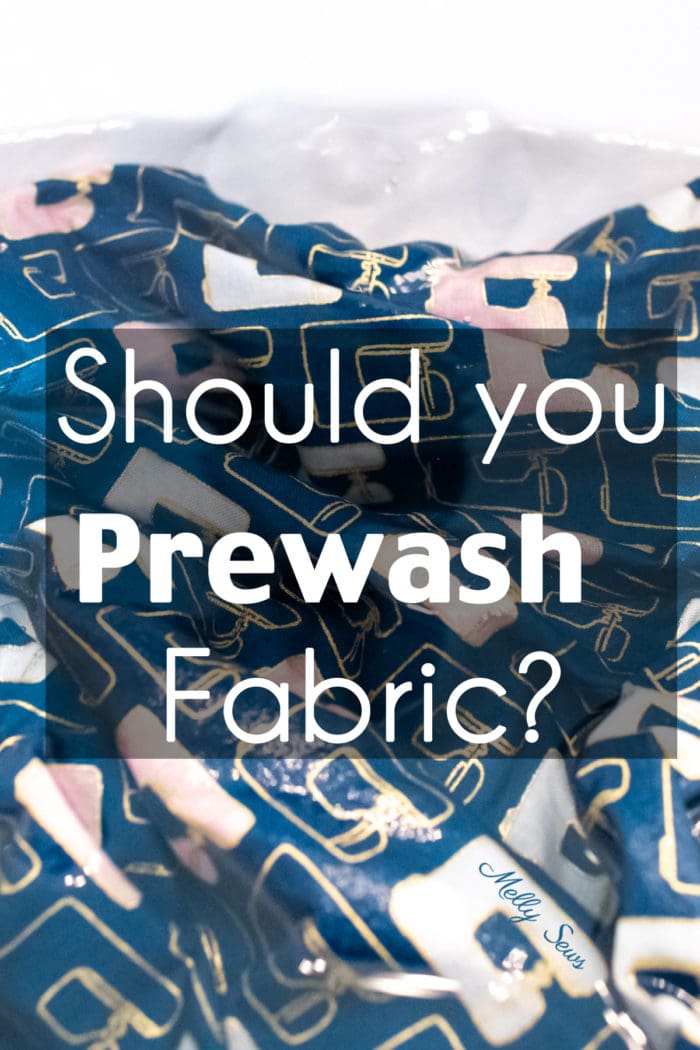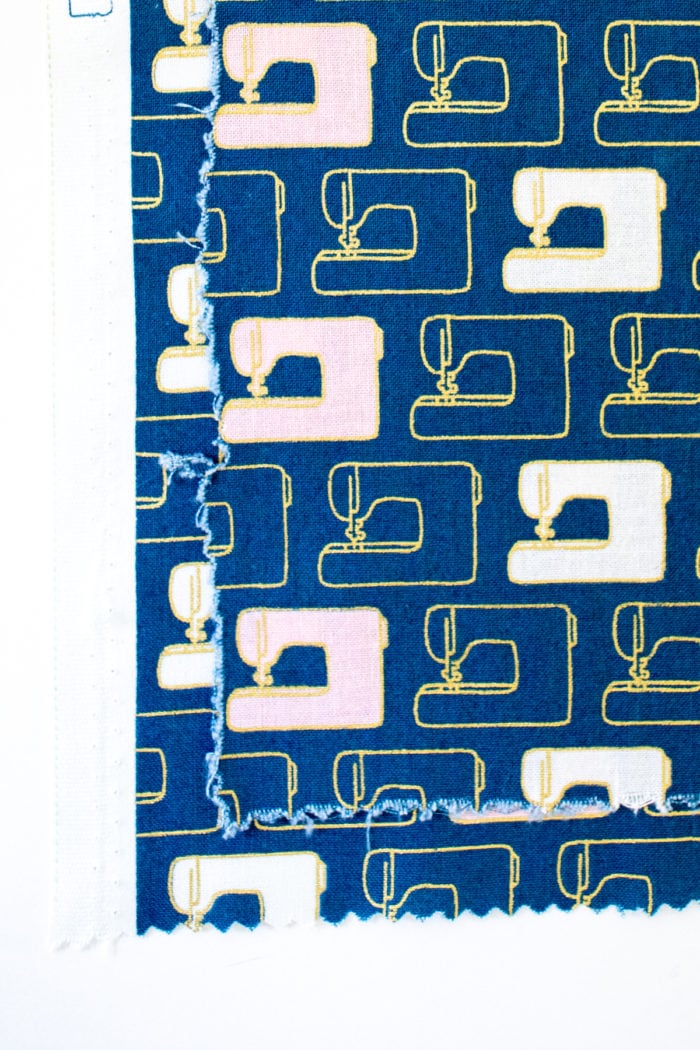When and how to pre-wash fabric for sewing

Hey y’all, today we’re going to talk about pre-washing fabric. I see the question about whether you should prewash fabric come up often, especially amongst beginners, so today we’re going to talk about it more.
Should you prewash your fabric?
If you are sewing garments, YES you should prewash your fabric! I made the video below to show you my reasoning. If it won’t load below for some reason, you can also watch on YouTube here.
So as I said in the video, prewashing fabric is the best way to make sure that your clothes don’t shrink after you sew them. For example, you can see how much the pre-washed fabric on top shrunk compared to the same size fabric that I did not wash which is on the bottom of the stack.

You should wash the fabric the same way you plan to wash the finished garment. So if you would normally wash on cold and tumble dry low, do that. In addition to getting the shrinking out of the way, pre-washing can also remove any extra dyes that might bleed.
Quilters may not always want to prewash because sometimes the shrinkage after quilting is desired. Stitching the quilting lines and then washing will give quilts a crinkled and vintage look if the fabric shrinks a bit. Just make sure your fabric for your quilt is either all prewashed or all not pre-washed, mixing the two types of fabric is a recipe for disaster!
What if you’re worried about fabric fraying in the wash? With some fabrics like rayon challis that is a legitimate concern. In that case you have a few options.
How to Prevent Fraying When Pre-Washing Fabric
- You can use a serger to overlock the cut edges
- You can do a faux overlock stitch with a regular machine
- You can use pinking shears to cut the raw edges
- You can fold the fabric in half and align the cut edges with each other, then sew those edges together with a 1/4 inch seam. This will keep fraying to the seam allowances only. After washing, cut at the stitching line to open your fabric back up. You do lose 1/2 inch of fabric with this method.

Megen
Team Prewash…you don’t know that fabrics life…dye migration,germs, shrinkage are all concerns.
Mea Cadwell
I will add allergies to sizings put on fabrics as well. It’s why I wash all new fabric I get.
Marlene Clausen
All my fabric (with the exception of pre-cuts for quilting) is washed. For the reasons you mentioned and also I don’t like the feel of sizing when I work with it. I put my serger in my laundry room when I remodeled it. Makes it easy. As for shrinking cotton on quilts, I love the crinkly, vintage look that you get washing and drying quilts. I have never found I don’t get that when I prewash cotton. As with garment fabrics, I wash and dry quilts when I finish them the same way I think the user will wash and dry them. My own, personal quilts get dried outdoors on my “solar dryer.”
Kati Kieffer - Kdk3kdk3
Oh I love the idea of stitching the two cut ends together! save on stitching and they don’t seem to wrap around in the wash so much too!
Mea Cadwell
I prewash everything – including precuts for quilts. Larger fabric gets washed in hot water and dried in the dryer. I have a small sink plunger that is dedicated for washing smaller pieces then they go in a mesh bag for drying. And, since I wash everything I don’t have to wonder if I washed it or not, because it already was.
Alex
When using cotton or linen, instead of prewashing, I usually scald it with a mix of hot water and vinegar – it serves to both pre-shrink and set the colors. I got into habit of scalding natural plant-based cloth when I began sewing from second-hand fabrics, as scalding also gets rid of more germs than just washing.
Virginia in Florida
I made the mistake of not prewashing some fabric for a grocery tote. When I washed after using, the lining fabric stained the outer fabric and it shrank so much that it is almost useless. I have been prewashing ever since. I even prewash some décor fabrics, but line dry. Prewashing has added to my ironing, but have had fewer surprises or disappointments.
Mavis Calow
Melly, I’m just starting sewing again after 50 years. Your article was very helpful. Thank you.
Mavis
Ariane
Prewashing… I know i should but don’t have the patience to wait (wash, dry, iron) when starting a project.
I also like the feel of crispiness that fabrics sometimes have before washing.
On a serious note, prewashing is important, because textiles sometimes have chemical residues leftover from manufacturing.
Tanja
The lady that taught me to sew told me to always pre-wash my fabric. She said you want the fabric to do whatever it’s going to do before making something out of it.
Charlotte
I prewash all my fabrics and I basically only use washable fabrics when sewing. I make a lot of clothes for my grandchildren and I know that those clothes will be washed often and I don’t want them to shrink. I also make totes and such to give as gifts and I don’t want them shrinking either.
Joan
I learned this the hard way. I made a nursing nightgown when I was expecting my second child. I did not prewash. It did indeed shrink the first time I washed it. Luckily since it was a loose fitting style it was still wearable and usable. Now I always prewash.
Robin
When I started sewing I was taught to always prewash those shrinkable fabrics. Especially the deep colored ones. I like the idea of scalding water + vinegar. In the 70’s+80’s especially the sizing smell really was really over powering to my sinuses & made me feel unwell. It’s not that bad now but I still wash them.
Sheila Robson
I think it’s a matter of hygiene as much as the risks of shrinkage and dye run. Most fabrics are manuafactured abroad these days (mainly in China) and heavens knows where they have been! I think this was especially important when Covid was about, but I still think it’s worth doing for all thoerse reasons. I find it bizarre that some people say – oh, I never bother with that, and then proceed to dress their small infants in clothing made from unwashed fabric.
Barbara
I’ve been mainly sewing with knit fabrics these last few years. If the knit has cotton in it, like cotton jersey, I will prewash with a quick cycle to basically wet it and spin most of the water out, and then I’ll dry it with a hotter than normal setting, because that’s where the shrinkage comes in. I’d rather have it shrink as a large piece of fabric than a shirt I’ve spent a bit of time on.
Mary Renn
About 50 years ago, when I learned to sew at age 9, fabric was treated with formaldehyde to keep it crisp and fresh looking, which can cause skin problems or worse. Always PREWASH for your own safety. I even wash store bought clothing because you don’t know how many people have tried on that garment. Safety first!